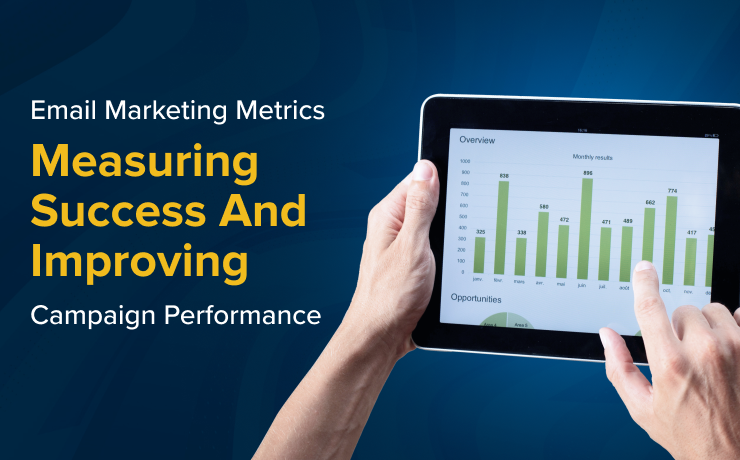Email Marketing Metrics: Measuring Success And Improving Campaign Performance

Sam Chadson Ng
Director of Content

Email marketing metrics are essential tools for evaluating the success of your campaigns. Recognizing these metrics can significantly enhance your strategy and ensure your messages reach the right audience.
What Are Email Marketing Metrics?
Email marketing metrics are numerical indicators that reflect the performance of your email campaigns. They provide insights into various aspects of your campaign, such as how many recipients opened your email, clicked on links, or unsubscribed. These metrics are invaluable for identifying what works and what needs improvement.
Why Track Email Marketing Metrics?
Tracking email marketing metrics is crucial because it helps you understand how your subscribers engage with your content. By analyzing these metrics, you can better understand your audience’s preferences, allowing you to tailor your campaigns for better results. For instance, if you notice a high click-through rate, your content resonates with your readers, prompting them to take action.
Key Email Marketing Metrics to Track
- Deliverability Rate
Deliverability rate measures the percentage of emails that successfully reach your recipients’ inboxes. A high deliverability rate indicates a healthy email list and effective email delivery practices. To calculate it, divide the number of delivered emails by the total sent emails and multiply by 100. Aim for a deliverability rate of 99% or higher.
- Open Rate
Open rate is the percentage of recipients who open your email. This metric is influenced by factors such as the subject line, sender name, and timing. To calculate the open rate, divide the number of opened emails by the total number of delivered emails and multiply by 100. A good open rate ranges from 20% to 22%. Experiment with different subject lines and personalization techniques to improve this metric.
- Click-to-Open Rate (CTOR)
CTOR measures the percentage of recipients who clicked on a link within your email after opening it. It provides a deeper insight into the effectiveness of your email content. Calculate CTOR by dividing the number of clicks by the number of opens and multiplying by 100. Aiming for a CTOR of around 10.5% is a good benchmark. Enhance your CTOR by including relevant content and strong calls-to-action (CTAs).
- Conversion Rate
The conversion rate is the percentage of recipients who completed a desired action, such as purchasing or filling out a form. This metric is critical for evaluating the effectiveness of your email marketing strategy. To calculate it, divide the conversions by the total number of delivered emails and multiply by 100. In e-commerce, a conversion rate above 2% is considered good. Improve your conversion rate by optimizing your email design and timing and offering compelling incentives.
- Unsubscribe Rate
The unsubscribe rate indicates the percentage of recipients who opt out of your email list after receiving an email. To calculate it, divide the number of unsubscribes by the total number of delivered emails and multiply by 100. A low unsubscribe rate (below 0.5%) is ideal. Maintain a low unsubscribe rate by sending relevant, engaging content and managing your email frequency.
- Bounce Rate
The bounce rate measures the percentage of emails that were not delivered. There are two types: soft bounces (temporary issues) and hard bounces (invalid addresses). Calculate it by dividing the number of bounced emails by the total number of sent emails and multiplying by 100. Aim for a bounce rate of 2% or less. Regularly clean your email list to remove invalid addresses and reduce bounce rates.
List Growth Rate
List growth rate reflects how quickly your email list is growing. To calculate it, subtract the number of unsubscribes from the number of new subscribers, divide by the total number of subscribers, and multiply by 100. Aim for a growth rate of 2.5% or higher. Encourage sign-ups through clear CTAs and incentives.
- Email Sharing or Forwarding Rate
This metric measures how often your emails are shared or forwarded. It’s calculated by dividing the number of shares or forwards by the total number of delivered emails and multiplying by 100. While there’s no standard benchmark, any sharing or forwarding is positive. Encourage sharing by including social sharing buttons and compelling content.
- ROI (Return on Investment)
ROI measures the revenue generated from your email campaigns relative to the costs. Calculate it by dividing the revenue by the total campaign cost and multiplying by 100. Email campaigns generally have a high ROI, often exceeding 4,200%. Enhance your ROI by optimizing your campaigns for conversions and continuously testing different elements.
- Number of Spam Complaints
This metric indicates how many recipients marked your email as spam. Calculate it by dividing the number of spam complaints by the total number of sent emails and multiplying by 100. Aim for 0% spam complaints. Reduce complaints by ensuring relevant content and providing a clear, easy-to-find unsubscribe option.
Using Email Marketing Metrics to Improve Campaigns
Understanding and analyzing your email marketing metrics can significantly improve your campaigns. Regularly reviewing these metrics allows you to identify patterns, test strategies, and make data-driven decisions. Utilize tools like email marketing services and marketing automation platforms to streamline the tracking process and gain deeper insights. By focusing on these key metrics, you can refine your email marketing strategy, enhance engagement, and drive better results for your business. Ready to elevate your email marketing campaigns? Contact us at SmartSites, and let our team of experts help you achieve remarkable results.
 Free
Consultation
Free
Consultation Free
Google Ads Audit
Free
Google Ads Audit







